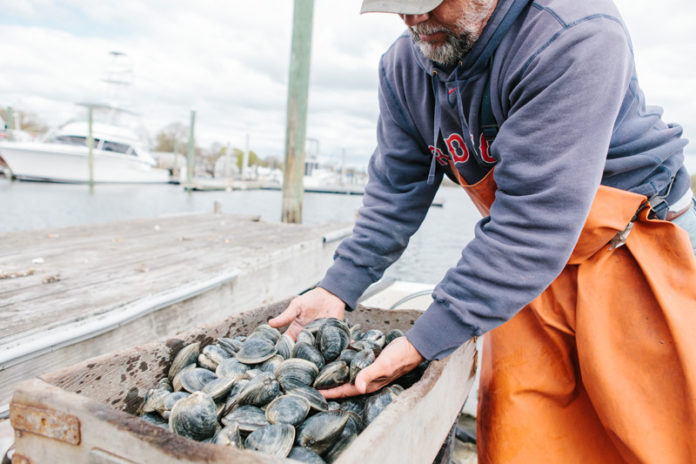
Even in the Ocean State, not everyone knows their clams.
You have quahogs, littlenecks, cherrystones and chowders, all names for the same species of bivalve. And head up or down the coast to another state and they attach different names to the same sizes, confusing even the dedicated seafood lover.
Out of all of the clams, the top-neck clam may be the most misunderstood.
It’s not at the top of the size chart and it doesn’t have a visible neck. It’s firmly in the modest middle of the clam spectrum and most people have never heard of it.
Because smaller clams are considered better, a good top-neck will draw less than a littleneck on the dock even though it could be twice as large.
But local shellfishermen and some chefs say the top-neck’s time has come for the sake of both consumers and the seafood industry.
With help from a $13,648 state grant, the Rhode Island Shellfishermen’s Association and hospitality company Newport Harbor Corp. are launching a top-neck clam promotional campaign with restaurant specials and a magazine spread.
“Top-necks are undervalued for what they are worth,” said Michael McGiveney, president of the Rhode Island Shellfishermen’s Association. “What is wonderful about them is when you split them in half you can cut the meat in half and have a good portion on each side. You’re getting two clams casino for the price of one.”
Elevating the profile of the top-neck clam is one example of a larger state effort to boost the Rhode Island seafood economy by stimulating demand for local marine products.
Last month, the R.I. Department of Environmental Management awarded six of 17 grants under the Local Agriculture and Seafood Act to advance local seafood sales.
Building off the success of local agriculture and the growth of farmers markets, the $70,000 in seafood grants are designed to help fishermen keep a larger share of the proceeds in-state instead of sharing it with distributors and middlemen.
The largest seafood-related grant, $20,000, went to the Department of Environmental Management itself to launch a Seafood Marketing Collaborative for branding locally caught seafood.
“We want to tap into the local food movement and give aquaculturists and fishermen the ability to follow the trails of agricultural entrepreneurial efforts,” said Ken Ayars, chief of the R.I. Division of Agriculture. “The first objective is creating an in-state market for local seafood.”
Specifics of the state branding effort have yet to be firmed up, but Ayars said the state has hired RDW Group of Providence to lead it.
The Local Catch Inc. has been working to connect local fishermen and consumers through farmers markets and Community Supported Fisheries programs since 2011, and was awarded $7,500 to bolster its marketing.
Local Catch President Richard Cook said the grant will help the company, which has a processing facility in Narragansett, to develop an online ordering system to build on its successful email newsletters.
“The state is really stepping up efforts for small farmers and, seeing as we are in almost all the farmers markets, they realized how important seafood is with that,” Cook said.
Brown Family Seafood LLC in South Kingstown is receiving a $16,000 grant to help build a new distribution center expected to open June 15.
Owner Christopher Brown Sr. said the facility will give Point Judith-area fishermen a new option for their catch with the potential to pay more and take advantage of the underutilized fish that larger processors don’t want.
“We have long perceived an opportunity to sell fish that don’t make sense for larger packing plants,” Brown said. “The more we can save on distribution costs helps the bottom line dramatically. We will do a little filleting of underutilized species and try to expand the market in state.”
In addition to working with Newport Harbor Corp. on the top-neck clam, the shellfishermen association also received $7,900 to produce three public-service announcements highlighting Rhode Island shellfish.
Peg Parker, executive director of the Commercial Fisheries Research Foundation, an industry-supported research group in South Kingstown, said promoting local seafood to the local market will have positive benefits, even if it remains a relatively small part of the revenue generated off Rhode Island landings.
“The state effort to brand and promote is a good one as there is tremendous room for growth in expanding consumption on the local level,” Parker said. “If we become known in Rhode Island for certain products, it will help in our desire to export, like what we see in other cities where they advertise Point Judith calamari.”
Parker said the state should not expect local consumption, however, to rival sales to out-of-state markets or take off like local agriculture.
“There has been a lot of success on the agriculture side that’s not necessarily applicable to seafood because of volume,” Parker said. “For agriculture, we can’t meet demand locally. With seafood, we could eat seafood three times a day and not satisfy all that we land and process.”
At Newport Harbor Corp., a magazine photo shoot for the top-neck clam has recently been completed and Chef Kevin Gaudreau has been working on recipes to feature the clam at the company’s restaurants, said spokesman Benjamin Emmons.
So far, Trio restaurant in Narragansett intends to promote the top-neck with a “spin on the classic stuffy,” Emmons said, and Hemenway’s in Providence will roast them. •












